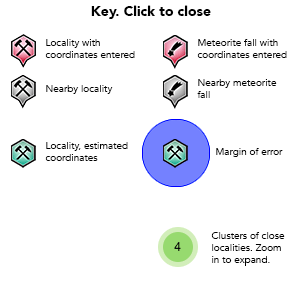US Forest Service 153, Clackamas Co., Oregon, USA

| Latitude & Longitude (WGS84): | 44° 55' 17'' North , 122° 6' 53'' West |
|---|---|
| Latitude & Longitude (decimal): | 44.92139,-122.11472 |
| GeoHash: | G#: 9rcpt1wy0 |
| Köppen climate type: | Csb : Warm-summer Mediterranean climate |
REF:Deposit:: OR. DEPT. GEOL. AND MIN. INDUST. SPECIAL PAPER 3, 1978,
Deposit:: PLATE 1, NO. 418.
Commodities (Major) - Stone - Crushed/Broken
Development Status: Past Producer
Commodity List
This is a list of exploitable or exploited mineral commodities recorded at this locality.No minerals currently recorded for this locality.
Regional Geology
This geological map and associated information on rock units at or nearby to the coordinates given for this locality is based on relatively small scale geological maps provided by various national Geological Surveys. This does not necessarily represent the complete geology at this locality but it gives a background for the region in which it is found.
Click on geological units on the map for more information. Click here to view full-screen map on Macrostrat.org
| Neogene 2.588 - 23.03 Ma ID: 3186305 | Cenozoic volcanic rocks Age: Neogene (2.588 - 23.03 Ma) Stratigraphic Name: Columbia River Basalt Comments: Columbia Plateau Lithology: Flood basalt(s); mafic volcanic rocks; basalt Reference: Chorlton, L.B. Generalized geology of the world: bedrock domains and major faults in GIS format: a small-scale world geology map with an extended geological attribute database. doi: 10.4095/223767. Geological Survey of Canada, Open File 5529. [154] |
| Miocene 5.333 - 23.03 Ma ID: 1495430 | Late Western Cascade Volcanics Age: Miocene (5.333 - 23.03 Ma) Description: Andesite of Nohorn Creek; 490m thick; andesite Lithology: Major:: {andesite flows, dark brown, reddish brown, pale red; pyroxene phenocrysts; lithology: andesite porphyry; pale red silicic block lavas blocks} Minor:: {tuff, pale green}; Minor:: {fluvial volcaniclastic rocks} Reference: R.L. Smith, W.P. Roe (compilers). Oregon Geologic Data Compilation, release 6. State of Oregon Department of Geology and Mineral Industries. [20] |
| Miocene - Oligocene 5.333 - 33.9 Ma ID: 3024878 | Undifferentiated tuffaceous sedimentary rocks, tuffs, and basalt Age: Cenozoic (5.333 - 33.9 Ma) Stratigraphic Name: Little Butte Volcanic Series; Mehama Volcanics; Breitenbush Formation; Mehama Formation; Molalla Formation Description: Heterogeneous assemblage of continental, largely volcanogenic deposits of basalt and basaltic andesite, including flows and breccia, complexly interstratified with epiclastic and volcaniclastic deposits of basaltic to rhyodacitic composition. Includes extensive rhyodacitic to andesitic ash-flow and air-fall tuffs, abundant lapilli tuff and tuff breccia, andesitic to dacitic mudflow (lahar) deposits, poorly bedded to well-bedded, fine- to coarse-grained tuffaceous sedimentary rocks, and volcanic conglomerate. Originally included in Little Butte Volcanic Series (Peck and others, 1964); includes Mehama Volcanics and Breitenbush Tuffs or Series of Thayer (1933, 1936, 1939), Breitenbush Formation of Hammond and others (1982), Mehama Formation of Eubanks (1960), and Molalla Formation of Miller and Orr (1984a). In Columbia River Gorge, includes Miocene and older rocks previously assigned to the Skamania Volcanic Series (Trimble, 1963), or to the Eagle Creek Formation (Waters, 1973). Lower parts of unit exhibit low-grade metamorphism with primary constituents altered to clay minerals, calcite, zeolites (stilbite, laumontite, heulandite), and secondary silica minerals. In contact aureoles adjacent to stocks and larger dikes of granitic and dioritic composition or in areas of andesitic dike swarms, both wallrocks and intrusions are pervasively propylitized; locally rocks also have been subjected to potassic alteration. Epiclastic part of assemblage locally contains fossil plants assigned to the Angoonian Stage (Wolfe, 1981) or of Oligocene age. A regionally extensive biotite-quartz rhyodacite ash-flow tuff, the ash-flow tuff of Bond Creek of Smith and others (1982), is exposed in southern part of Western Cascade Range near and at base of unit. A K-Ar age of 34.9 Ma was determined on biotite from the tuff (Smith, 1980). Ash-flow tuffs, higher in the section and in the same area, have been radiometrically dated at 22 to 32 Ma by potassium-argon methods (J.G. Smith, unpublished data; Evernden and James, 1964; Fiebelkorn and others, 1983). In the central part of the Western Cascade Range, the unit has yielded a number of K-Ar ages in the range of about 32 to 19 Ma (Verplanck, 1985, p. 53-54). A fission-track age of 23.8 ñ 1.4 Ma was obtained on a red, crystal-rich ash-flow tuff (J.A. Vance, oral communication, 1983) collected at an elevation of about 3,000 ft on U.S. Highway 20 west-southwest of Echo Mountain. Most ages from basalt and basaltic andesite lava flows are in the range of about 35 to 18 Ma. Locally intruded by small stocks of granitoid rocks and by dikes, sills, plugs, and invasive flows of basaltic andesite and basalt; in many places, the intrusions are indistinguishable from poorly exposed interbedded lava flows; K-Ar ages on several of the mafic intrusions or invasive flows are about 27 to 31 Ma. In places subdivided into Tus, Tut, and Tub Lithology: Major:{basalt,basaltic andesite}, Minor:{dacite,andesite,conglomerate,mixed clastic} Reference: Horton, J.D., C.A. San Juan, and D.B. Stoeser. The State Geologic Map Compilation (SGMC) geodatabase of the conterminous United States. doi: 10.3133/ds1052. U.S. Geological Survey Data Series 1052. [133] |
Data and map coding provided by Macrostrat.org, used under Creative Commons Attribution 4.0 License



